| |
POWER 3: 24-week efficacy and safety results of TMC114/r in treatment experienced HIV patients
|
| |
| |
Reported by Jules Levin
".....A total of 31% of patients had previously used TPV (tipranavir). Baseline resistance to TPV (using a clinical cut-off of 3.0) was associated with an increase in TMC114 FC; however, the observed change in VL of -1.38 log10 copies/mL for TPV-resistant patients was close to the overall value of -1.74 log10 copies/mL for all patients who initiated treatment with TMC114/r 600/100mg bid.... Treatment-emergent grade 3 or 4 lipid elevations were uncommon and none led to withdrawal; grade 3 or 4 liver-related abnormalities were also uncommon..... Mean changes in lipid laboratory parameters between baseline and Week 24 were small, with mean changes (SD) from baseline of -0.34 (3.20), 0.43 (1.37) and 0.42mmol/L (0.89) recorded for triglycerides, total cholesterol and VLDL, respectively...."
Presented at the 12th Annual Conference of the British HIV Association (BHIVA), 29 March-1 April 2006, Brighton, UK.
Molina J-M,1 Cohen C,2 Katlama C,3 Grinsztejn B,4 Timerman A,5 Pedro R,6 De Meyer S,7 de Bethune M-P,7 Vangeneugden T,7 Lefebvre E8
1Hopital St-Louis, Division of Clinical Microbiology and Infectious Diseases, Paris, France; 2University of the Witwatersrand, Johannesburg, South Africa; 3Hopital Pitie-Salpetriere, Paris, France;
4Institut De Pesquisa Clinica Evandro Chagas, Rio de Janeiro, Brazil; 5PAM Heliopolis, Sao Paulo, Brazil; 6HC Unicamp, Campinas, Brazil; 7Tibotec BVBA, Mechelen, Belgium; 8Tibotec Inc., Yardley, USA
ABSTRACT
Objective: In the POWER 1 and 2 (TMC114-C213 and C202) studies, TMC114 with low-dose ritonavir (TMC114/r) provided a sustained efficacy compared to control. The efficacy and safety of the selected dose for treatment-experienced HIV patients, 600/100mg bid, were further investigated in the non-randomised, open-label TMC114-C215 trial of POWER 3 to further investigate over a longer term the safety and efficacy of TMC-114.
Methods: Study inclusion/exclusion criteria were the same as for POWER 1 and 2. Patients received TMC114/r 600/100mg bid plus an optimised background regimen (OBR) based on screening resistance testing and treatment history. Analysis was intent-to-treat (ITT) (TLOVR algorithm).
Results:
In total, 327 patients were enrolled; 246 reached Week 24 and are included in this analysis. Median baseline characteristics were similar to those of POWER 1 and 2: viral load (VL) was 4.6 log10 copies/mL and CD4 count was 115 cells/mm3.
HIV RNA <50 copies/mL and a reduction in HIV RNA of >1 log10 copies/mL were achieved by 40% and 65% of patients, respectively.
Baseline TMC114 fold change (FC) was the strongest predictor of virological response.
CD4 counts rose by a mean of 80 cells/mm3.
The most common adverse events (AEs) were diarrhoea (14%) and nausea
(10%).
Grade 3/4 triglyceride, cholesterol, ALT and AST elevations occurred in 6%, 4%, 2% and 1% of patients, respectively.
Individual grade 3/4 AEs occurred in 1% patients. The six deaths (2%) were not treatment-related.
Conclusions: POWER 3 efficacy and safety results confirm and extend those observed in POWER 1 and 2. TMC114/r 600/100mg bid provided patients with a substantial reduction in VL and an increase in CD4 counts, and was generally safe and well-tolerated.
Patients and study design
POWER 3 is an open-label, non-randomised analysis, which was conducted to assess the long-term efficacy and safety of TMC114/r 600/100mg bid in HIV-1-infected treatment-experienced patients.
All 327 patients who initiated treatment with TMC114/r at the recommended dose for treatmentexperienced patients in the TMC114-C215 and TMC114-C208 trials were included in the integrated POWER 3 analysis. Of these patients
- 303 were newly recruited and had not participated in any prior TMC114 study
- 24 had 'rolled over' from the control arm of previous TMC114 studies following significant virological failure (defined as <0.5 log10 reduction in plasma HIV RNA from baseline at or beyond Week 12).
Inclusion and exclusion criteria were similar to POWER 1 and 2. Major inclusion criteria for patients included in the POWER 3 analysis were
- HIV RNA >1,000 copies/mL
- 33 months prior NRTI treatment, and at least one NNRTI used in a failing regimen
- 31 PI treatment received for 33 months, with stable PI treatment received for 38 weeks prior to screening
- 31 PI mutation from the IAS-USA 2004 list of primary PI mutations: D30N, L33I/F, M46I/L, G48V, I50V/L, V82A/F/L/T/S, I84A/C/V, L90M12
- no prior treatment with TMC114.
During screening, investigators selected an OBR for each patient on the basis of resistance testing and an evaluation of treatment history. The OBR, which consisted of NRTIs with or without enfuvirtide (ENF), was initiated at the baseline visit. Investigators were permitted to modify the OBR during the study period but
were not allowed to use any other PI or NNRTIs with TMC114/r.
RESULTS
Baseline characteristics
A pre-planned analysis was conducted with data collected up to 24 September 2005. At this time, 327 patients had been enrolled and were subsequently included in the safety analysis; 246 of these patients had either reached Week 24 or discontinued earlier and were therefore included in the efficacy analysis.
Examination of the baseline characteristics of the patients included in POWER 3 (Table 1) reveals that this population had previously received extensive ARV treatment: virtually all patients (98%) had received at least two PIs, one NNRTI and four NRTIs. These characteristics were similar to those of the POWER 1 and 2 trials.8-11
According to the IAS-USA 2005 classification,13 the enrolled patients had a median of three primary PI mutations; as a consequence only 20% of patients had HIV which showed sensitivity to another licensed PI at screening (based on Antivirogram data) excluding tipranavir (TPV), which was not available at the time of study recruitment.
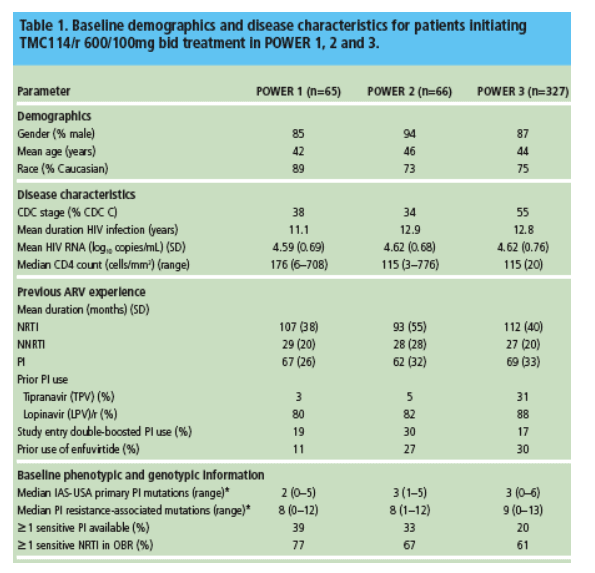
Overall efficacy at Week 24
The primary efficacy endpoint of >/= 1 log10 reduction at HIV RNA was observed in 65% (160/246) of patients (Figure 1a).
Reductions in HIV RNA levels to <400 copies/mL and <50 copies/mL were seen in 57% (n=141) and 40% (n=98; Figure 1b) of patients, respectively.
The mean reduction in HIV RNA from baseline to Week 24 was -1.65 log10 (standard deviation [SD]=1.36).
CD4 counts at Week 20 rose by a mean of 80 cells/mm3 (SD=99) (Figure 2), which is similar to the result from the integrated Week 24 primary efficacy analysis of TMC114/r patients in the POWER 1 and 2 trials, where CD4 counts rose by 92 cells/mm3.14
These results are similar to those obtained in the POWER 1 and 2 trials.8-11
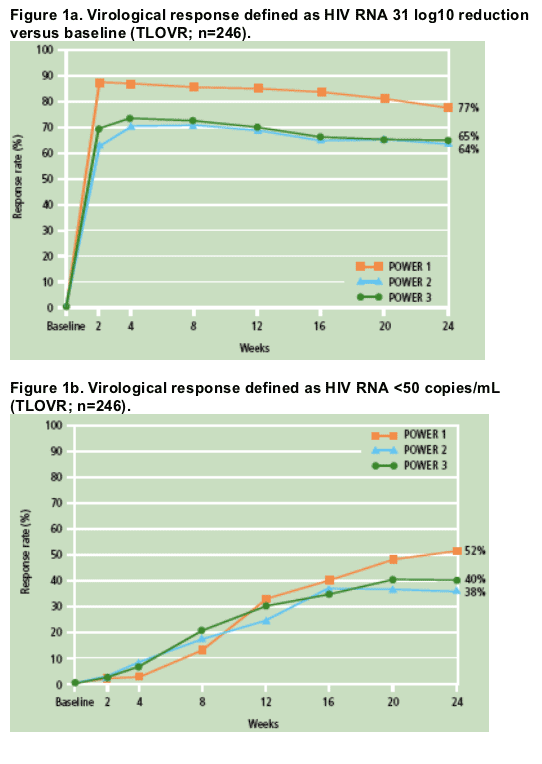
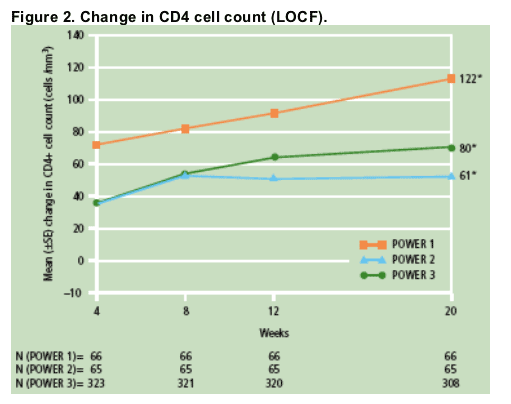
Factors influencing treatment response
The impact of baseline factors on treatment response at Week 24 is shown in Table 2.
In a multivariate analysis, baseline phenotypic TMC114 FC was the strongest predictor of response, which was also demonstrated in POWER 1 and 2. A higher proportion of patients achieved a VL of <50 copies/mL with a baseline TMC114 FC 10 (13%).
There was poor correlation between number of primary PI mutations at baseline and virological response.
Higher rates of virological suppression (HIV RNA <50 copies/mL) were achieved by those who had >/= 1 susceptible ARV in their OBR
- 29%, 48% and 41% of patients with 0, 1 or 32 NRTIs in their OBR, respectively
- 45%, 27% and 42% of patients using ENF for the first time (naive), using ENF non-naively and not using ENF, respectively.
A total of 31% of patients had previously used TPV. Baseline resistance to TPV (using a clinical cut-off of 3.0) was associated with an increase in TMC114 FC; however, the observed change in VL of -1.38 log10 copies/mL for TPV-resistant patients was close to the overall value of -1.74 log10 copies/mL for all patients who initiated treatment with TMC114/r 600/100mg bid.14
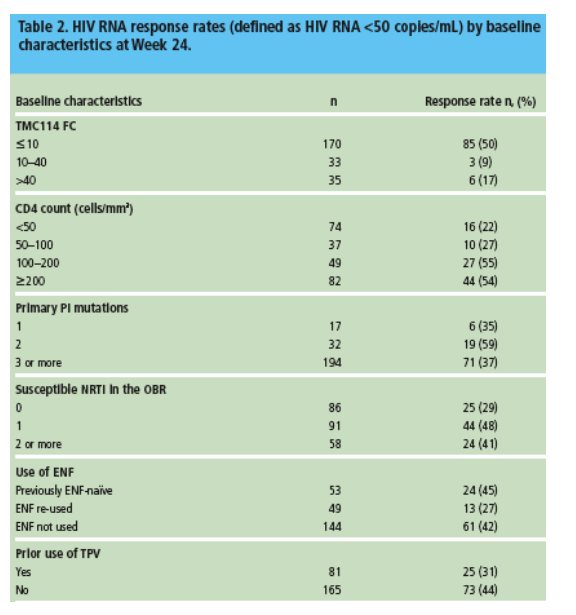
Safety
TMC114/r was generally well tolerated and no specific toxicity was associated with TMC114/r treatment.
The most common treatment-emergent clinical AEs were diarrhoea (14%), nasopharyngitis (11%) and nausea (10%) (apart from ENF-related injection-site reactions, which occurred in 19% of patients receiving ENF).
The majority of AEs were grade 1 (mild) or 2 (moderate) in severity; 25% of patients reported >/=1 grade 3 or 4 AE. Grade 3 or 4 AEs occurring with an incidence of >/= 2% are displayed in Table 3. Treatment-emergent grade 3 or 4 lipid elevations were uncommon and none led to withdrawal; grade 3 or 4 liver-related abnormalities were also uncommon.
The overall incidence of serious AEs was 13% and none of the six deaths (2%) was considered related to TMC114/r by the trial investigators.
Notably, there was a low rate of treatment discontinuation due to AEs (2%). Overall, 8% patients discontinued (2% due to virological failure).
Mean changes in lipid laboratory parameters between baseline and Week 24 were small, with mean changes (SD) from baseline of -0.34 (3.20), 0.43 (1.37) and 0.42mmol/L (0.89) recorded for triglycerides, total cholesterol and VLDL, respectively.
There was a pronounced decrease in triglycerides at Week 24 for patients who received LPV/r during screening then received TMC114/r during the study period relative to those who did not receive LPV/r. No obvious differences in changes from baseline in other lipid parameters were observed between these two
subgroups of patients.
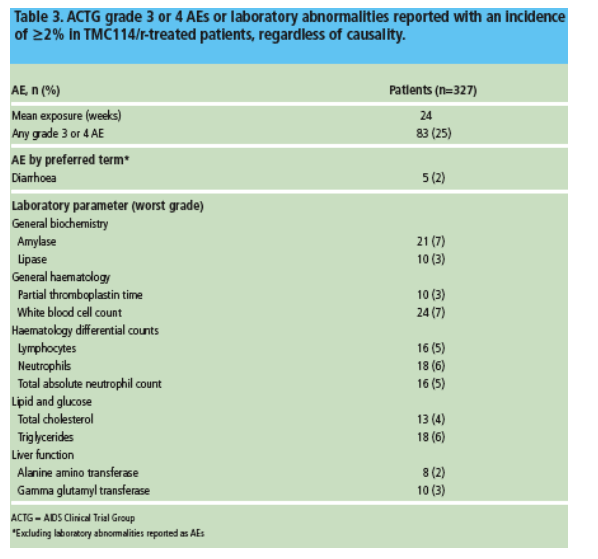
Author Conclusions
The findings from POWER 3 extend and confirm the observations from POWER 1 and 2.8-11 TMC114/r 600/100mg bid (the recommended dose for treatment-experienced patients) provides sustained VL reductions and CD4 increases in treatment-experienced HIV patients.
Together with POWER 1 and 2, the results of a substantial subset of POWER 3 patients clearly demonstrate that suppression of VL to undetectable levels can be achieved for many treatment-experienced patients.
The safety analysis from this larger treatment-experienced patient population confirms the findings seen in the POWER 1 and 2 studies, and further indicates that TMC114/r 600/100mg bid is generally safe and well tolerated: no unforeseen AEs were observed in this large patient set.
Phase III randomised controlled trials of TMC114 in different patient populations are ongoing (ARTEMIS [TMC114-C211; treatment-naive patients]; TITAN [TMC114-C214; treatment-experienced patients]; DUET 1 and DUET 2 [TMC114-C206 and TMC114-C216; treatment-experienced patients]).
References
1. Cahn P, Hicks C. 10th European AIDS Conference, Dublin, Ireland, November 17-20, 2005. Abstract LBPS3/8.
2. Elston RC, et al. XVth World AIDS Conference, Bangkok, Thailand, July 11-16, 2004. Abstract MoOrB1055.
3. Johnson M, et al. 7th International Congress on Drug Therapy in HIV Infection, Glasgow, Scotland, November 14-18, 2004. Abstract PL14.4.
4. Gathe JC, et al. AIDS 2004;18:1529-37.
5. Walmsley S, et al. N Engl J Med 2002;346:2039-46.
6. De Meyer S, et al. Antimicrob Agents Chemother 2005;49:2314-21.
7. Hoetelmans R, et al. 10th Conference on Retroviruses and Opportunistic Infections, Boston, MA, USA, February 10-14, 2003. Abstract 549.
8. Katlama C, et al. 3rd IAS Conference on HIV Pathogenesis and Treatment, Rio de Janeiro, Brazil, July 24-27, 2005.
Abstract WEOaLB0.102.
9. Wilkin T, et al. 45th Interscience Conference on Antimicrobial Agents and Chemotherapy,Washington DC, USA, December 16-19,
2005. Abstract 2860.
10. Grinsztejn B, et al. 3rd IAS Conference on HIV Pathogenesis and Treatment, Rio de Janeiro, Brazil, July 24-27, 2005.
Abstract WePeLB6.201.
11. Berger D, et al. 45th Interscience Conference on Antimicrobial Agents and
Chemotherapy,Washington DC, USA, December 16-19, 2005. Abstract H-1094.
12. Johnson VA, et al. Top HIV Med 2004;12:119-24.
13. Johnson VA, et al. Top HIV Med 2005;13:51-7.
14. Tibotec BVBA; data on file.
|
|
| |
| |
|
|
|